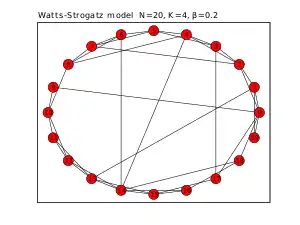NetworkX
NetworkX is a Python library for studying graphs and networks. NetworkX is free software released under the BSD-new license.
 A graph created with NetworkX | |
| Original author(s) | Aric Hagberg Pieter Swart Dan Schult |
|---|---|
| Developer(s) | Many others |
| Initial release | 11 April 2005[1][2] |
| Stable release | 2.5[3]
/ 22 August 2020 |
| Repository | |
| Written in | Python |
| Operating system | Cross-platform |
| Type | Software library |
| License | BSD-new license |
| Website | networkx |
| Network science | ||||
|---|---|---|---|---|
| Network types | ||||
| Graphs | ||||
|
||||
| Models | ||||
|
||||
| ||||
|
||||
Features
- Classes for graphs and digraphs.
- Conversion of graphs to and from several formats.
- Ability to construct random graphs or construct them incrementally.
- Ability to find subgraphs, cliques, k-cores.
- Explore adjacency, degree, diameter, radius, center, betweenness, etc.
- Draw networks in 2D and 3D.
Suitability
NetworkX is suitable for operation on large real-world graphs: e.g., graphs in excess of 10 million nodes and 100 million edges.[4] Due to its dependence on a pure-Python "dictionary of dictionary" data structure, NetworkX is a reasonably efficient, very scalable, highly portable framework for network and social network analysis.[5]
See also
References
- NetworkX first public release (NX-0.2), From: Aric Hagberg, Date: 12 April 2005, Python-announce-list mailing list
- NetworkX initial release, NX-0.2, hagberg – 2005-04-11, Project Info – NetworkX, Registered: 2004-10-21, SourceForge.net
- https://networkx.org/documentation/stable/release/release_2.5.html
- Aric Hagberg, Drew Conway, "Hacking social networks using the Python programming language (Module II – Why do SNA in NetworkX)", Sunbelt 2010: International Network for Social Network Analysis.
- Aric A. Hagberg, Daniel A. Schult, Pieter J. Swart, Exploring Network Structure, Dynamics, and Function using NetworkX, Proceedings of the 7th Python in Science conference (SciPy 2008), G. Varoquaux, T. Vaught, J. Millman (Eds.), pp. 11–15.
- http://sagemath.org/links-components.html
External links
This article is issued from Wikipedia. The text is licensed under Creative Commons - Attribution - Sharealike. Additional terms may apply for the media files.
